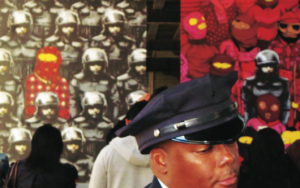By Nina Wikstøl
Staff Writer

Throughout his monthlong show on the streets of New York, the famous graffiti artist known as Banksy has turned the city into a giant game of treasure hunt this October.
Unveiling a new art piece on a daily basis, Banksy communicates with the public through social media and his website, banksyny. com. Posting only a picture of his recent work, and the located area, he leaves it up to New Yorkers to find the exact location—and they do.
People are getting swept up in the hype that is Banksy, and rush to see his art work before it is defaced. The mysterious artist, who remains unidentified to public, calls his monthly exhibit “Better Out Than In,” meaning that art is better on the streets where it is free rather than in a museum.
Banksy challenged authorites with his first piece. On October 1, he painted a kid standing on another kid’s back, reaching for a spray can inside a sign reading: “Graffiti is illegal.”
LIU Post students are captivated by Banksy and his mischievous work. Broadcasting students Rob Hairston and Karoline Onsrud defines graffiti as a visual way of seeing people’s thoughts, thus being art and a way of expression. “Graffiti is more accepted these days,” said Onsrud. “It started as vandalism, but it has developed into an impressive art form which is much more accepted these days. Banksy sends political messages that concerns all of us look at how his work makes all these people flock together!” she added. The British street artist has gone from being a cultural icon in the graffiti community to the name on everyone’s lips.
He wins his audience over with political and social messages, as well as creativity. There is often a double meaning behind his work. However, regardless of Banksy’s increasing popularity, graffiti is still looked at as an illegal action. Or is it?
Banky’s work has forced a new debate about the definition of graffiti. What started out in the ‘70s, with young people tagging their names on buildings and such, has evolved into a form competition with each artist “out-doing” each other.
Banksy has become a living example of how graffiti has expanded its limits. CBS New York reports that his drawings are being protected by plexiglass, and in some cases even by security guards.

The whole meaning behind graffiti has transformed from something that used to be an illegal action into becoming a legal way to make big money.
While certain building owners jump with joy when finding Banksy’s valuable paintings on their property, the NYPD and Mayor Bloomberg are less than enthralled by the brazen acts of the artist, according to CNN. “Graffiti ruins people’s property and is a sign of decay and loss of control,” Bloomberg said.
Despite Banksy leaving his marks all over the city, the NYPD is having a hard time finding him. The search after the elusive artist is still ongoing by law enforcement.
Although not legalized by law, there’s no doubt that Banksy’s work has opened people’s eyes to see graffiti as something more than just vandalism.






Be First to Comment